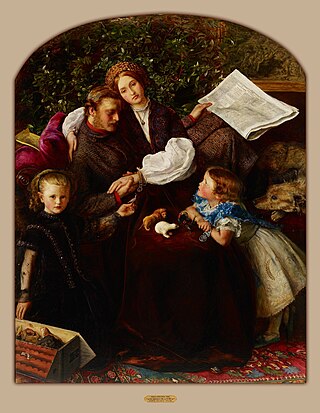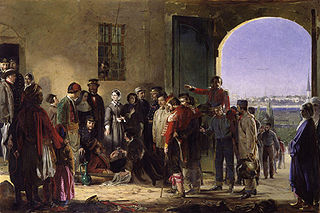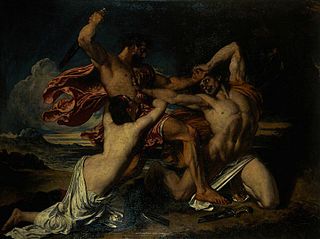
John William Waterhouse was an English painter known for working first in the Academic style and for then embracing the Pre-Raphaelite Brotherhood's style and subject matter. His paintings are known for their depictions of women from both ancient Greek mythology and Arthurian legend. A high proportion depict a single young and beautiful woman in a historical costume and setting, though there are some ventures into Orientalist painting and genre painting, still mostly featuring women.

Elizabeth Southerden Thompson, later known as Lady Butler, was a British painter who specialised in painting scenes from British military campaigns and battles, including the Crimean War and the Napoleonic Wars. Her notable works include The Roll Call, The Defence of Rorke's Drift, and Scotland Forever!. She wrote about her military paintings in an autobiography published in 1922: "I never painted for the glory of war, but to portray its pathos and heroism." She was married to British Army officer William Butler, becoming Lady Butler after he was knighted.

Malcolm Timothy Gladwell is a Canadian journalist, author, and public speaker. He has been a staff writer for The New Yorker since 1996. He has published seven books. He is also the host of the podcast Revisionist History and co-founder of the podcast company Pushkin Industries.

Roger Fenton was a British photographer, noted as one of the first war photographers.

Arkhip Ivanovich Kuindzhi or Arkhyp Kuindzhi was a landscape painter of Greek descent from the Russian Empire.

William Simpson was a Scottish artist, war artist and war correspondent.

The 28th Regiment at Quatre Bras is an oil painting on canvas from 1875, painted by Elizabeth Thompson. She became better known as Lady Butler after her marriage to William Butler in 1877. The painting is 97.2 centimeters (38.3 in) high and 216.2 centimeters (85.1 in) wide. It is in the National Gallery of Victoria, Melbourne, Australia.

Peace Concluded, 1856 (1856) is a painting by John Everett Millais which depicts a wounded British officer reading The Times newspaper's report of the end of the Crimean War. It was exhibited at the Royal Academy in 1856 to mixed reviews, but was strongly endorsed by the critic John Ruskin who proclaimed that in the future it would be recognised as "among the world's best masterpieces". The central figure in the painting is a portrait of Millais's wife Effie Gray, who had previously been married to Ruskin. It is now in the Minneapolis Institute of Arts.

Sir Coutts Lindsay, 2nd Baronet, was a British artist and watercolourist.

Jerry Barrett was an English painter of the Victorian era. His most notable work was the Crimean War depiction The Mission of Mercy: Nightingale receiving the wounded at Scutari (1858) which is in the National Portrait Gallery (London), paired with Queen Victoria's First Visit to her Wounded Soldiers.

Scotland Forever! is an 1881 oil painting by Lady Butler depicting the start of the charge of the Royal Scots Greys, a British heavy cavalry regiment that charged with other British heavy cavalry at the Battle of Waterloo in 1815. The painting has been reproduced many times and is considered an iconic representation of the battle itself, and of heroism more generally.

The Society of Women Artists (SWA) is a British art body dedicated to celebrating and promoting fine art created by women. It was founded as the Society of Female Artists (SFA) in 1855, offering women artists the opportunity to exhibit and sell their works. Annual exhibitions have been held in London since 1857, with some wartime interruptions.

The remnants of an army, Jellalabad (sic), January 13, 1842, better known as Remnants of an Army, is an 1879 oil-on-canvas painting by Elizabeth Thompson, Lady Butler. It depicts William Brydon, assistant surgeon in the Bengal Army, arriving at the gates of Jalalabad in January 1842. The walls of Jalalabad loom over a desolate plain and riders from the garrison gallop from the gate to reach the solitary figure bringing the first word of the fate of the "Army of Afghanistan".

The Combat: Woman Pleading for the Vanquished is a large oil painting on canvas by English artist William Etty, first exhibited in 1825 and now in the National Gallery of Scotland. Inspired by the Elgin Marbles and intended by the artist to provide a moral lesson on "the beauty of mercy", it shows a near-nude warrior whose sword has broken, forced to his knees in front of another near-nude soldier who prepares to inflict a killing blow. A woman, also near-nude, clutches the victorious warrior to beg him for mercy. Very unusually for a history painting of the period, The Combat does not depict a scene from history, literature or religion and is not based on an existing artwork, but is instead a scene from the artist's own imagination.
Ellen Louise Clacy (1853–1916) was a British watercolorist. She participated numerous times with the Royal Academy throughout her career from 1870 to 1916, and her works include landscapes, scenes of rural life, and history painting. She was the daughter of travel writer Ellen Louise Clacy.

Applicants for Admission to a Casual Ward is an 1874 oil painting by British painter Luke Fildes, a key work in nineteenth-century British social realism. The painting shows a street scene of impoverished and weary men, women and children waiting by the side of the road outside a police station, huddled against the cold evening, waiting to be given a ticket for temporary admission to a workhouse for the night. Many resisted taking up permanent residence at the workhouse, where men and women would be separated, and would be required to work to pay for their board and lodging; once they entered, many only left when they died. Instead, from 1864, if the police in London certified that a person was genuinely in need, they could stay for one night on a "casual" basis, and leave the next morning, but they would have to queue up again for temporary admission the next evening. Poverty and vagrancy were pressing issues in Victorian London, and the issuance of "casual" tickets doubled from around 200,000 in 1864 to over 400,000 in 1869.

The Last Muster is an 1875 oil painting by Sir Hubert von Herkomer, based on his wood engraving Sunday at the Chelsea Hospital published in The Graphic on 18 February 1871. The painting is in the Lady Lever Art Gallery in Port Sunlight, Wirral.

The Defence of Rorke's Drift is an 1880 painting by Elizabeth Thompson, Lady Butler depicting the 1879 Battle of Rorke's Drift which took place during the Anglo-Zulu War of 1877 to 1879. The battle and the men who fought in it were made famous in the 1964 film Zulu.

The Bomber Mafia: A Dream, a Temptation, and the Longest Night of the Second World War is a 2021 book by Malcolm Gladwell that examines the US Bomber Mafia of World War II, which advocated precision aerial bombing as a means to win a war. Gladwell stated the audiobook for The Bomber Mafia came about as an expansion of material from his podcast Revisionist History, and that the print book originated from the audiobook. The book follows the Bomber Mafia, especially Major General Haywood S. Hansell, and the development of a high-altitude precision aerial bombardment strategy in World War II as a means to limit casualties. After difficulties in applying the Bomber Mafia's theoretical strategy, Major General Hansell was replaced by Major General Curtis LeMay, who utilized tactical changes such as attacking Japanese population centers with napalm to ensure a Japanese surrender. Upon release, The Bomber Mafia was met with mixed reviews, with reviewers praising its audiobook version but criticizing the book for a lack of detail and factual accuracy.
Modest is a 2023 play by Ellen Brammar, with music by Rachel Barnes. A biographical play on the painter Elizabeth Thompson and her poet sister Alice, it includes strong elements of song, drag, music hall and gender nonconformity.


















